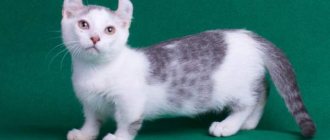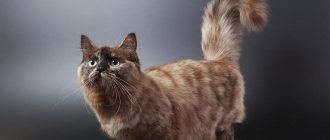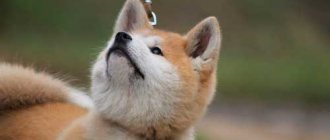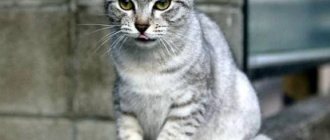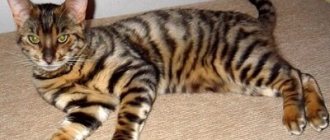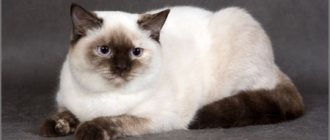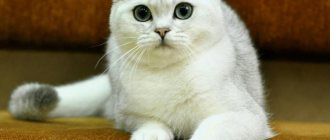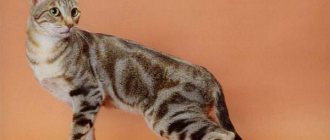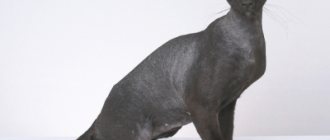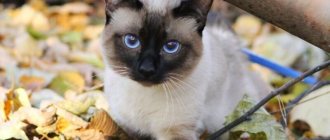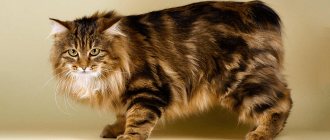Video
* We invite you to watch a video about the Munchkin . In fact, in front of you is a playlist in which you can select and watch any of 20 videos about a given cat breed by simply clicking on the button in the upper right corner of the window. In addition, the material contains quite a lot of photos. By looking at them you can find out what Munchkin looks like.
In this article:
|
Rate the material!
[Total votes: 2 Average: 3]
There are many cat breeds in the world, but the munchkin can be considered one of the most unusual. These short-legged cats look very cute and always attract attention with their appearance. At the same time, despite the disproportionate hind legs, the Munchkin cat breed is distinguished by its friendly disposition and jumping ability. In this material we will talk in detail about cats of this breed and give a lot of interesting facts about munchkins.
What to look for when choosing a kitten
Sometimes cute babies with short legs are offered for sale second-hand in various Viber groups or social networks. You can immediately fall in love with the purr from the photo, but you shouldn’t rush to pay for a real purchase. Before purchasing a pet, you need to observe it in reality, paying attention to the following points:
- The baby must be at least 3 months old. A very small kitten separated from its mother may die;
- Healthy babies are quite active. They are active, playful and cocky. If the baby is passive and does not want to run, he may have health problems;
- The baby's legs should be even and the fur should be smooth. It is important that the eyes are clean and free of discharge;
- A shy kitten that is afraid to approach a person is not the most suitable pet. A child who shows aggression is also not the best option;
- In the litter, a mother with short legs may have babies with long legs. They have the same pedigree as their shorter brothers and sisters and may in the future become the parents of offspring with a standard build for the breed. If you like such a baby, you shouldn’t refuse him.
When buying a kitten, you should ask the breeder about the parents, their habits and pedigree. It is also worth asking the owner for documents for the animal. It is advisable that by the time of purchase the baby is accustomed to the tray.
Cats with short legs can become true friends and true members of your family. All the breeds listed above are distinguished by their kind nature, curiosity and playfulness. Just look at these adorable kittens - how can you not fall in love with them at first sight?
The origin story of munchkins
The first mentions of short-legged cats date back to the 30s of the last century. There are documented eyewitness accounts that tell in detail about such animals. But the Second World War completely destroyed not only several of these cats, but also their owners.
The real birth of the breed happened only in the 80s. A modest American teacher living in Louisiana brought home a stray cat with unusually short hind legs. She brought offspring with the same feature.
A veterinarian became interested in cats with short hind legs, after which the appearance of a new breed was officially recorded. There were enthusiasts who started breeding munchkins, and the first breeders appeared.
The Munchkin cat breed made its debut at the exhibition in 1991, and in the mid-90s the breed was recognized internationally. By the beginning of the 21st century, the number of cats of this breed reached several tens of thousands and a unified breed standard was developed, which exists to this day. Moreover, the first hybrids began to appear, as munchkins began to be crossed with Bengal cats and Sphynxes.
Interesting fact: The name of the Munchkin breed was taken from Frank Baum's book The Wizard of Oz. This was the name of the short, but cheerful and friendly people inhabiting a magical land. And this name suits the cat breed perfectly, as they have a friendly disposition.
Munchkins were brought to Russia in 2002 and were initially considered a very exotic breed of cat. However, nowadays there are nurseries for breeding munchkins in all major cities of the country, and cats of this breed have ceased to be something unusual.
Munchkin - description of the breed
Munchkins are very easy to distinguish from other cat breeds. Even people far from biology can easily do this. A unique feature of this breed is that all munchkins have a long, elongated body and very short legs, which are two (and sometimes three) times shorter than their normal size.
At the same time, the mutated gene did not affect the spine at all and the cats remained just as flexible and mobile. The internal organs did not undergo changes either. Short legs and a flexible body allow cats to be very mobile and agile.
In most cases, munchkins are medium-sized cats. The average weight of the animal is about 4 kilograms. If a munchkin's weight exceeds 5 kilograms, then it is considered obese and the cat is prescribed a preventative diet. Despite their small size, munchkins have a muscular body and their short legs do not prevent them from jumping to considerable heights.
The head size is average. Fully proportional to the body. The ears are wide and rounded. If the cat has long hair, then there may be clearly visible tassels on the ears. The neck is short and strong. The munchkin's nose can be straight or it can have a slight arch; this is allowed by the breed standard.
Munchkins have large and round eyes, giving the animal a sweet appearance. Green, blue and yellow eye colors are allowed. At munchkin shows, deep and rich eye color is highly valued.
But cats' fur can be either long or short. Long-haired munchkins resemble a smaller version of Maine Coons, while short-haired ones resemble miniature British cats. Deviations from the breed are considered to be a round head, curly hair and an excessively protruding chest bone. Such munchkins are culls and are not allowed for breeding.
Lamkin
The breed is distinguished by curly hair and weight, from 1800 to 4000 grams. Representatives of this breed are often also called “dwarf rexes.” The progenitors of these cats are Selkirk Rex and Munchkins. For now, the breed is still considered experimental by breeders.
Lamkin is a breed of short-legged cats with curly hair.
Representatives of this breed have long hair. Therefore, such long-haired pets require special care.
The owner will need a special comb for curly cats and free time to comb it at least once a week. To make the curls look beautiful, after combing they need to be sprayed with water.
Popular munchkin colors
There is no single color standard for munchkins. The breed standard allows not only short-haired or long-haired cats, but also a wide variety of colors. This is due to the fact that munchkins are a natural breed of cat that appeared as a result of a natural mutation, and are not an artificially bred animal.
By and large, these are ordinary yard cats, incorporating the colors of all known breeds. So at exhibitions you can see munchkins of all colors, from bright red to noble gray. Bicolor and tricolor cats are allowed, as well as stripes and spots.
Moreover, it often happens that munchkins are surprisingly similar in color to Siamese, Scottish or Bengal cats. And this is not surprising, since similar colors are obtained by crossing munchkins and cats of the above-mentioned breeds.
Interesting fact: The Munchkin breed standard is still in its infancy. Therefore, cats of all colors are allowed for breeding. However, it is planned that by 2025, color criteria will be developed that will strictly outline the requirements for animals.
In the last few years, munchkins have appeared without hair at all. This is the result of crossing munchkins and sphinxes. At an exhibition in Berlin (2017), several families of similar cats were presented, and they caused a real sensation among animal lovers.
The most valuable and rare colors among munchkins are chocolate and marbled. There are still few such cats, but they are intensively bred in nurseries. We can safely say that in the coming years there will be many more munchkins of this color and these colors will become common.
Character and habits of munchkins
All owners of these cats note their incredible friendliness and playfulness. By nature, munchkins are companion cats, and their behavior is very similar to that of a small dog.
It should be said that munchkins are not suitable for gloomy and unsociable people, as they will demand attention from their owner and may not leave his side for hours. But for active and life-loving people, this breed is ideal. Munchkins get along well with small children and will brighten up the lives of older people.
In addition, munchkins are very patient. Even if small children begin to carry them, they will release their claws only as a last resort, when there is no way to tolerate them. Strangers cause surprise, not fear, in these cats. The munchkin cat will definitely come up to meet the guest and allow himself to be petted.
Cats of this breed are self-sufficient, but they do not like to be alone. Of course, they will get used to the daily absences of their owners for work, but in the evening they will need to pay attention. The Munchkin will sit on the owner’s lap and lie there for a good hour.
Fear and timidity are completely unusual for a munchkin. On the contrary, this cat breed is inquisitive. There is no doubt that the munchkin will explore all corners of the apartment and climb into those places where it seems impossible to climb.
After just a few years of life, the munchkin will follow its owner like a dog, moving with him from room to room. Dachshund cats (as munchkins are often called) are often walked on a leash, and these animals happily walk outside, exploring new territory.
Munchkins get along well with cats of other breeds and can even get along with dogs. Thanks to their high adaptive abilities, these cats can travel with their owners without damaging their psyche.
Interesting facts about munchkins
Munchkins are a very unusual breed of cat. It is not surprising that there are a lot of interesting facts about them.
Here are just a few of them:
- In the 50s, the USSR had its own breed of short-legged cats. They were called the “Stalingrad kangaroo”, as these animals lived in the vicinity of what is now Volgograd. At that time, biologists associated changes in limb size with the harsh living conditions of animals in the post-war USSR. Unfortunately, by the 60s there was nothing left of the “Stalingrad Kangaroo” breed;
- Munchkins stand perfectly on their hind legs. There are some cats that can stand on their hind legs for a good ten minutes. The fact is that the lower limbs of the animal are very powerful, and, leaning on the tail, the cat can stand in a column for a long time;
- Breeders do not recommend crossing two munchkins. Crossing identical genes leads to a high probability of the birth of deformed and dead kittens in the offspring that are born. The best option for crossing is a classic cat and a munchkin cat;
- Naturally, the shortest cat in the world is the Munchkin. The American cat Lily, whose height was only 13.5 centimeters from the floor, is included in the Guinness Book of Records. The record remains to this day;
- The leg length of cats of this breed is divided into three types: standard (up to 20 centimeters), short (up to 16 centimeters) and super short (up to 13 centimeters). Cats with super short legs are quite rare;
- Munchkins are often called magpie cats because they steal and hide shiny things to play with later.
Also, the peculiarities of such cats include the fact that the average age of their life is about 13 years, which is less than that of ordinary cats. Veterinarians associate this with deformation of the spine and hind limbs, which inevitably leads to a number of serious diseases that appear with age.
Pros and cons of munchkins
Like any other animal, munchkins have their own advantages and disadvantages that you should be aware of when planning to get this animal.
The advantages of Munchkin cats include:
- Friendly disposition. Munchkins are great for large families with small children. These are patient and balanced creatures, able to get along with both family members and other animals. Unlike many modern breeds, munchkins are not susceptible to neuroses and are not prone to aggression;
- Unpretentiousness in food. Cats of this species can be fed both natural food and special dry food. The main thing is to accustom animals to such food from childhood and not change the food system throughout their lives. Switching from natural food to artificial food (or vice versa) will affect the cat’s health in the most negative way;
- Strong immunity. Munchkins are not susceptible to most cat diseases. They are not afraid of cold weather and tolerate heat well. You can even walk them outside without the risk of catching a cold.
However, there are also plenty of negative points.
The disadvantages of munchkins include:
- Thieving. Shiny buttons, pocket mirrors and polished cigarette cases - all these (and many other) items a cat can steal and hide in a secluded place. Moreover, an intelligent animal can change its secluded place and often owners have to look for valuable items in new corners of the apartment;
- Prone to obesity. Thanks to their cute appearance, munchkins can be excellent at begging for food. And the owners need to show strength of character, because these cats quickly gain excess weight and are very difficult to lose it in the future. Therefore, if you want to extend the life of your pet, do not overfeed it, despite all its requests;
- Susceptible to bone diseases. The cat has a strong immune system, but by the 10th year of life it will inevitably have problems with the spine and hind legs. This needs to be taken into account when planning to get a munchkin.
Characteristics of short-legged cats
What are the benefits of cats with short legs? The owners of such pets claim that they have an amazing character. They are intelligent, sociable, good-natured, inquisitive and cheerful, that is, they are suitable as a companion for any person, even with the most gloomy character. These cats are affectionate and playful, so they will return a good mood to any owner.
At the same time, they are self-sufficient and intelligent, so they will not “bother” you when you don’t want it. Such pets easily get along with other cats or other pets. They are not at all embarrassed by their short legs, but they can always stand up for themselves, since they are naturally endowed with a strong spirit.
Breeding munchkins
Anyone wishing to breed cats of this breed should know that the gene for “short legs” is inherited through one of the parents. Moreover, if two parents are of the Munchkin breed, then the offspring will have stillborn kittens or outright freaks.
Therefore, one of the parents must have normal paws. Otherwise, all offspring will be culled. For this reason, munchkin breeding should be done by professionals who are able to choose the right pair and thereby minimize the influence of mutagens.
Interesting fact: In addition to the fact that munchkins cannot be crossed with each other, fold-eared and short-tailed cats cannot be paired with them. Offspring burdened with an additional mutation gene will be small in number and non-viable.
Each new breeding of munchkins should be aimed at improving the breed or obtaining new colors. It is highly not recommended to carry out mating at home. Pedigree cats mate in nurseries under the supervision of a veterinarian.
Cats that have reached puberty (over 1.5 years of age) are allowed to breed. Moreover, cats can breed 3-4 times a year, and cats should give birth no more than 2 times a year. In all other respects, the reproduction of munchkins is no different from the reproduction of ordinary cats. In addition, we can say that cats of this breed take very gentle and touching care of cats, sometimes performing real serenades for them.
Usually there are 3-4 kittens in a litter, and if the pair is chosen correctly, then the risk of death or critical mutation is reduced to zero.
Care and maintenance
Despite the fact that these breeds are very mobile and active, they still cannot climb or jump high. It is necessary to prepare a room in which there will be no poisonous plants, sharp corners, fragile objects, hanging wires and objects that the pet will want to try to jump on. Prepare:
- Convenient access to places of use (tray, bowls of food and water)
- Comfortable sleeping place: the lounger should not be too soft and high;
- Choose a cat litter box with low sides;
- Buy two scratching posts: horizontal and vertical;
- A set of toys – your pet needs active games;
Short-legged cats need an active lifestyle and regular games. They are quite active by nature, and additional physical activity will strengthen their spine, which accounts for the shift in the center of gravity of the animal’s body.
The pathological curve of the back of short-legged cats requires regular physical activity.
IMPORTANT: a sedentary lifestyle can lead to the development of lordosis in your pet. A feature of short-legged breeds is the pathological curvature of the spine, to which the center of load of the animal’s body is shifted. For this reason, it is necessary to regularly maintain the animal’s physical condition.
Proper care and maintenance consists of selecting a complete diet, vitamin complexes and supplements that will strengthen the animal’s immune system and generally allow it to maintain normal health indicators. Like all other pets, short-legged cats need constant monitoring of their health, routine vaccination, deworming, and hair treatment for parasites and fleas. Pet care should be comprehensive and regular, which will significantly improve the quality of life and prolong the age of the pet.
Munchkin care
From birth to the last days of their lives, munchkins remain very clean cats. They easily learn to use the tray, do not throw litter around, and eat from the bowl very carefully. But these cats have an extremely negative attitude towards water procedures.
The animal must be washed twice a year, in spring and autumn. For washing you need to use a special shampoo. You should not immerse the cat's head; on the contrary, you should avoid getting water in the nose, eyes and ears. After bathing, you need to dry your cat with a soft terry towel or a hairdryer at the lowest temperature.
The animal's eyes and ears should be washed as needed. If suppuration in the eyes or wax plugs in the ears appear too often, you should contact your veterinarian. Nails need to be trimmed once a month. For these purposes, you should purchase special tweezers.
Despite its short legs, the Munchkin does not require special care. It is enough to comb the cat so that the fur is healthy and does not get into clumps. For a short-haired animal, it is enough to brush it once a week. Long-haired cat 2-3 times a week depending on the condition of its coat.
Naturally, you will need a scratching post. It is advisable to have several such devices, as this will help keep the corners in the rooms intact. Scratching posts need to be mounted at a low height, so munchkins, even standing on their hind legs, are not very tall.
The cat should have several small toys. Otherwise, she will play with objects that she can find herself. Twice a year, the munchkin must be taken to the veterinarian for examination. Vaccination should be carried out once a year.
Bambino
You can buy a kitten of this breed at a nursery; most likely, they will give you a young Canadian Sphynx. When purchasing, pay attention to the cleanliness of the animal's eyes and ears, as well as its character. The kitten should not be afraid of you. The price for a representative of this breed can vary from 70 to 350 thousand rubles.
Banbino is a breed of hairless, short-legged cats.
This is a hairless cat breed with short legs that was developed by crossing Munchkins with Sphynx cats in the United States. The name of the breed literally translates from Italian as “child”. The average weight of such a cat is about 3 kg. They also have an endearing habit of sitting on their hind legs.
As for care, he does not need special care. The cat has good physical characteristics, loves to frolic, and is able to remember and perform simple tricks. In other words, kittens of this breed have excellent health. True, they often freeze due to the lack of fur, so try to keep the air temperature at home from falling below 22 degrees. By the way, you can try a blouse on your cat if you decide to take her for a walk. Most likely, she will not refuse.
Separation from the owner negatively affects the bambino: the animals even refuse to eat. This factor must be taken into account when deciding to get a pet. Cats tolerate moving, travel, and new surroundings well and quickly adapt to new conditions.
Munchkin diet
As mentioned above, a cat’s diet can be either natural or artificial. If a natural diet is chosen, then it is necessary to feed the munchkin high quality meat products.
For example, pork (and especially fatty pork) is completely prohibited. The cat should be given well-cooked beef, veal and boneless poultry. The meat diet should make up 60-70% of the total food. The remaining 30-40% should be filled with vegetables, both raw and boiled.
Interesting fact: Salt and sugar should be completely eliminated from munchkins' food. Fats of animal origin should be minimized, as their excess will lead to obesity in the cat.
But the following foods should not be fed to munchkins under any circumstances:
- Mutton;
- Fatty pork;
- Any legumes (peas, lentils, etc.);
- All types of cereals.
In addition, cats should never be fed food from their own table. They will definitely not benefit the cat and are guaranteed to cause obesity. Sometimes it can be very difficult not to give a cat a tasty morsel, since they can be excellent at begging for food and often do this standing on their hind legs.
If an artificial diet is chosen, then it is best to opt for high-quality feed. These foods are initially balanced, containing meat and plant components, as well as vitamins. Such food does not require any additives or supplements. This will save owners from the need to buy and prepare meat and vegetables.
You need to feed the kitten 4-5 times a day. An adult cat is fed 2 times a day, morning and evening. If you increase the number of meals, the cat will gain excess weight in just a few months.
Diseases
Despite their small stature, munchkins quickly gain weight, so the optimal feeding frequency is from 2 to 5 times a day. If you have small paws, obesity adversely affects the health of your furry pet. Increased stress also often leads to joint diseases.
A congenital defect of the limbs sometimes disrupts the structure of other parts of the body. Curvature of the spine leads to compression of vital organs, including:
- heart;
- lungs;
- trachea.
Munchkins are prone to obesity
If a kitten has such features at birth, its lifespan is reduced several times.
Attention! Crossing animals that are both SL type is not recommended as a quarter of the offspring do not survive.
Diseases and health problems
It was previously mentioned that munchkins are distinguished by good health and excellent natural immunity, which helps them fight many diseases. However, excessively short hind legs make themselves felt.
Munchkin cats suffer from spinal lordosis. With this disease, the muscles in the animal’s thoracic region weaken and atrophy. This not only prevents the animal from moving normally, but will also cause inevitable problems with the lungs and heart.
Spinal lordosis can be caused by two reasons. The first is genetic predisposition. It is for this reason that munchkin breeding should be trusted to professionals. Only experienced breeders will be able to correctly select a pair, which will allow them to avoid incurable genetic diseases.
The second reason is obesity. Excessive weight is guaranteed to cause problems with the spine. Therefore, the cat owner must carefully monitor its nutrition, not overfeed the animal and not give in to the most touching requests for more. The cat's weight should be monitored monthly, and if it is exceeded, a diet is necessary.
Important fact: It is necessary to vaccinate your animal annually. Vaccinations will help avoid most viral diseases and keep your cat healthy and healthy.
If the munchkin does get sick, then there is definitely no need to self-medicate. The cat must be immediately taken to a good veterinary clinic and carefully follow all the doctor’s instructions. Remember that the munchkin's health and longevity is in the hands of its owner. And if the owner takes care of the pet, then he will live a long and rich life without serious illnesses.
Veterinary
All the many advantages of munchkins - both their external charm and wonderful character - fade into the background if the animal is unhealthy. It is important not only to choose the right pet for yourself that is strong and disease-resistant, but also to constantly maintain it in optimal physical shape. And here a lot depends on the owner - on proper maintenance of the cat at home and qualified veterinary care.
Breed defects and diseases
Munchkins who lead a sedentary lifestyle are at risk. At the same time, against the background of regular overeating, such an unpleasant and dangerous disease as lordosis can develop. Burdened with excessive loads, the spine bends beyond measure, internal organs are subjected to pressure and even deformation. To avoid pathology, you just need to promptly provide the animal with a normal diet and physical activity, and also visit a veterinarian from time to time for preventive examinations.
Pay close attention to your pet's posture
